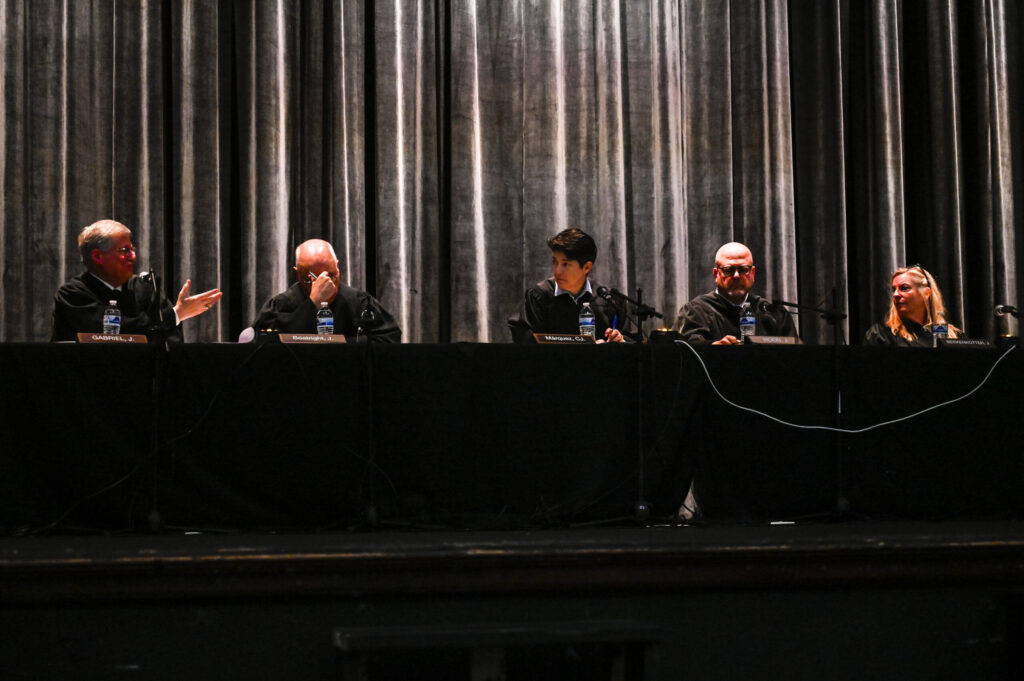Aurora dentist accused of killing wife with poison had drugged her years prior, ‘best friend’ testifies
Nicole “Nikki” Harmon choked back tears Monday morning telling a jury she was “best friends” with Angela Craig, who was allegedly poisoned twice by her husband, James Craig.
Craig told Harmon about the first time he drugged Angela in 2019 — an attempt to commit suicide without Angela waking up to stop him, Harmon said in 18th Judicial District Judge District Judge Shay Whitaker’s Arapahoe County courtroom Monday morning.
Now, Craig is accused of poisoning his wife with lethal doses of cyanide, arsenic and tetrahydrozoline, which is found in over-the-counter eyedrops, in March of 2023. Angela, 43, died March 18, 2023 at University Hospital.
Craig was arrested on March 19, 2023, on suspicion of first-degree murder in connection with her death. The arrest affidavit said that Craig’s dental business was in financial trouble and he was beginning a relationship with a Texas orthodontist named Karin Cain.
A doctor who cared for Angela in the days before her death said Craig’s reaction to learning she was dying was “lackluster,” adding that Craig told doctors to stop providing life-saving care before Angela was medically pronounced brain dead — a decision the doctor told jurors he found “unusual.”
A forensic toxicologist who reviewed blood samples from Angela, both before and after her death, said the levels of cyanide in her blood point to an administration of the toxin while she was in the hospital.
Angela Craig’s friend Harmon wouldn’t look directly at Craig when Deputy District Attorney Ryan Brackley asked her to identify him in the courtroom during the fifth day of testimony Monday. He sat emotionless nearby in a suit next to his defense attorneys.
Harmon took the witness stand Monday morning, describing to the jury more than 20 years of friendship with the Craigs, saying Angela was her “best friend” since 2000.
“We raised our kids together, saw each other every day,” Harmon said. “We hung out on the porch and watched our kids play.”
Harmon then reflected on an incident in 2019 when Craig confided in the Harmons about a “sexual addiction” he’d dealt with for a “long time.” Craig told the Harmons that one night he had planned to commit suicide with an injection, and that he had drugged Angela to make sure “she didn’t wake up and stop him.”
Angela and Harmon’s friendship was never the same afterward, and Angela was angry that Harmon hadn’t been there for her, Harmon said.
Defense Attorney Lisa Moses questioned Harmon on the Craig family’s financial state, saying Harmon called their financial habits “horrible.” Harmon agreed that they spent a lot of money.
Peter Sottile, the third witness called Monday, is a pulmonology and critical care physician at University of Colorado who took care of Angela at the hospital the days before she died.
It is “unusual” for a person in their 40s to come into the emergency room with “vague complaints” and then “basically die in front of you,” Sottile said.
His team did a CAT scan, which showed severe brain swelling, a “perplexing” find given that the severity of swelling would normally come from a period of not having a pulse, which had not happened to Angela, he said.
When it was clear Angela’s brain pressure was likely to be fatal, Sottile asked to talk to Craig. She was not brain dead yet, he said.
Craig’s response to this news was “unusual,” Sottile said, describing his response as a “lackluster response to hearing that your wife who was otherwise healthy was likely dead.”
When asked if they should keep fighting to keep her alive, Craig said “no,” which was also “unusual,” Sottile said.
“Regardless of whether or not as a professional I thought we could get some kind of recovery … it is unusual for families of young patients like this to say we should just stop everything,” Sottile said.
His team gave Angela the antidote for cyanide after hearing she may have been exposed to it, but her brain swelling was “likely not reversible” at that point, he said.
Defense Attorney Ashley Whitham questioned the doctor on peoples’ reactions to bad news, which can vary widely from person-to-person, Sottile said, asking if he has seen people react with little emotion to bad news.
“It’s far less common, but it happens,” he said, also agreeing that patients are often not the ones disclosing “self-ingestion” of toxins.
Witness Justin Brower is a forensic toxicologist at NMS Laboratories, he said when he took the stand Monday afternoon. Brower reviewed Angela’s blood samples taken at both 11:50 a.m. and at 8:21 p.m. on March 15.
“It looks like there would have to be a second administration of cyanide while she was in the hospital,” Brower said, pointing to an increase of the toxin in her blood between the two tests.
Karla Walker, a toxicology lab director at MedTox Laboratories, who oversaw the testing of cyanide levels in Angela’s blood, said they found 5.865 milliliters per liter of cyanide in her blood.
A normal cyanide level in a person who doesn’t smoke is 0.025 milliliters per liter, and in smokers, 0.41 milliliters per liter. Amounts above 3 mm can be fatal.
Lisa Moses questioned both lab specialists on the process of getting the blood results from the people who took them to the labs, and the fact that neither witness actually did the testing themselves, just oversaw the testing and reviewed the results.
“You don’t know the manner, you don’t know the exact time and it’s fair to say the way it’s absorbed would make a difference and you don’t know the way it was absorbed,” Moses said.
Rose Eppolito Spychala, a nurse who treated Angela the days before she died, held up an IV bag and line in her witness testimony, showing the jury how it works and confirming it is the same kind that Angela would have been hooked up to.
She showed the jury the simple process of screwing a syringe onto an IV line and injecting something into the line.
Spychala said Craig went into Angela’s room for a period of time on March 15, then came out later saying Angela was having “arm pain.” When nurses went in, she was having a seizure, Spychala said.
Whitham asked Spychala if Craig ever tried to intervene on medical care, to which she said no. He stayed out of the way of medical professionals who rushed to her care, Spychala confirmed. He was also “emotional,” she confirmed, and took pictures from outside.
Arapahoe County Coroner Kelly Lear was the final witness Monday evening, saying Angela’s cause of death was acute cyanide and tetrahydrozoline poisoning. Based on prior medical records, text messages from Angela leading up to her death and the cause of death, Lear ruled her manner of death homicide, she told jurors.
The trail, which continues Tuesday, is expected to last two more weeks.











